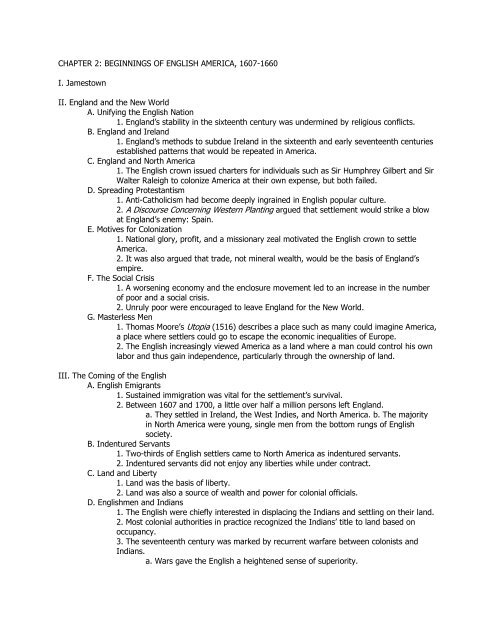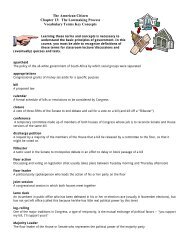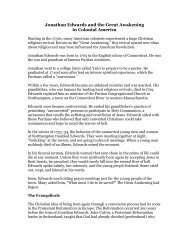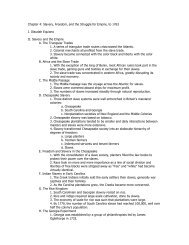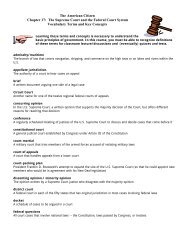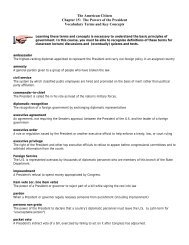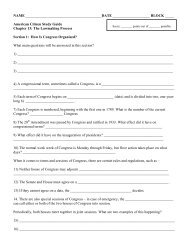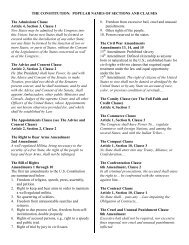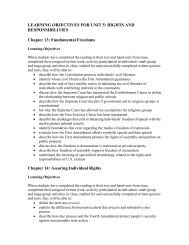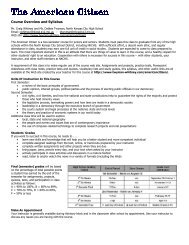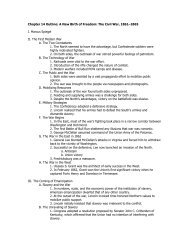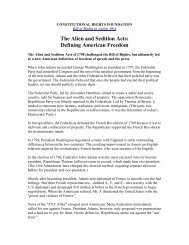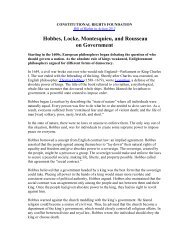CHAPTER 2: BEGINNINGS OF ENGLISH AMERICA, 1607-1660
CHAPTER 2: BEGINNINGS OF ENGLISH AMERICA, 1607-1660
CHAPTER 2: BEGINNINGS OF ENGLISH AMERICA, 1607-1660
Create successful ePaper yourself
Turn your PDF publications into a flip-book with our unique Google optimized e-Paper software.
<strong>CHAPTER</strong> 2: <strong>BEGINNINGS</strong> <strong>OF</strong> <strong>ENGLISH</strong> <strong>AMERICA</strong>, <strong>1607</strong>-<strong>1660</strong><br />
I. Jamestown<br />
II. England and the New World<br />
A. Unifying the English Nation<br />
1. England’s stability in the sixteenth century was undermined by religious conflicts.<br />
B. England and Ireland<br />
1. England’s methods to subdue Ireland in the sixteenth and early seventeenth centuries<br />
established patterns that would be repeated in America.<br />
C. England and North America<br />
1. The English crown issued charters for individuals such as Sir Humphrey Gilbert and Sir<br />
Walter Raleigh to colonize America at their own expense, but both failed.<br />
D. Spreading Protestantism<br />
1. Anti-Catholicism had become deeply ingrained in English popular culture.<br />
2. A Discourse Concerning Western Planting argued that settlement would strike a blow<br />
at England’s enemy: Spain.<br />
E. Motives for Colonization<br />
1. National glory, profit, and a missionary zeal motivated the English crown to settle<br />
America.<br />
2. It was also argued that trade, not mineral wealth, would be the basis of England’s<br />
empire.<br />
F. The Social Crisis<br />
1. A worsening economy and the enclosure movement led to an increase in the number<br />
of poor and a social crisis.<br />
2. Unruly poor were encouraged to leave England for the New World.<br />
G. Masterless Men<br />
1. Thomas Moore’s Utopia (1516) describes a place such as many could imagine America,<br />
a place where settlers could go to escape the economic inequalities of Europe.<br />
2. The English increasingly viewed America as a land where a man could control his own<br />
labor and thus gain independence, particularly through the ownership of land.<br />
III. The Coming of the English<br />
A. English Emigrants<br />
1. Sustained immigration was vital for the settlement’s survival.<br />
2. Between <strong>1607</strong> and 1700, a little over half a million persons left England.<br />
a. They settled in Ireland, the West Indies, and North America. b. The majority<br />
in North America were young, single men from the bottom rungs of English<br />
society.<br />
B. Indentured Servants<br />
1. Two-thirds of English settlers came to North America as indentured servants.<br />
2. Indentured servants did not enjoy any liberties while under contract.<br />
C. Land and Liberty<br />
1. Land was the basis of liberty.<br />
2. Land was also a source of wealth and power for colonial officials.<br />
D. Englishmen and Indians<br />
1. The English were chiefly interested in displacing the Indians and settling on their land.<br />
2. Most colonial authorities in practice recognized the Indians’ title to land based on<br />
occupancy.<br />
3. The seventeenth century was marked by recurrent warfare between colonists and<br />
Indians.<br />
a. Wars gave the English a heightened sense of superiority.
E. Transformation of Indian Life<br />
1. English goods were eagerly integrated into Indian life.<br />
2. Over time, those European goods changed Indian farming, hunting, and cooking<br />
practices.<br />
a. Exchanges with Europeans stimulated warfare between Indian tribes.<br />
F. Changes in the Land<br />
1. As the English sought to reshape Indian society and culture, their practices only<br />
undermined traditional Indian society.<br />
2. Settlers fenced in more land and introduced more crops and livestock, transforming<br />
the natural environment.<br />
IV. Settling the Chesapeake<br />
A. The Jamestown Colony<br />
1. Settlement and survival were questionable in the colony’s early history because of high<br />
death rates, frequent change in leadership, inadequate supplies from England, and<br />
placing gold before farming.<br />
2. By 1616, about 80 percent of the immigrants who had arrived in the first decade were<br />
dead.<br />
3. John Smith began to get the colony on its feet.<br />
B. From Company to Society<br />
1. New policies were adopted in 1618 so that the colony could survive.<br />
a. Headright system.<br />
b. A charter of grants and liberties.<br />
c. Slavery; the first slaves arrived in 1619.<br />
C. Powhatan and Pocahontas<br />
1. Powhatan, the leader of thirty tribes near Jamestown, eagerly traded with the English.<br />
2. English-Indian relations were mostly peaceful early on.<br />
a. Pocahontas married John Rolfe in 1614, symbolizing Anglo-Indian harmony.<br />
D. The Uprising of 1622<br />
1. Once the English decided on a permanent colony instead of merely a trading post,<br />
conflict was inevitable.<br />
a. Opechancanough led an attack on Virginia’s settlers in 1622.<br />
2. The English forced the Indians to recognize their subordination to the government at<br />
Jamestown and moved them onto reservations.<br />
3. The Virginia Company surrendered its charter to the crown in 1624.<br />
E. A Tobacco Colony<br />
1. Tobacco was Virginia’s “gold” and its production reached 30 million pounds by the<br />
1680s.<br />
2. The expansion of tobacco led to an increased demand for field labor.<br />
F. Women and the Family<br />
1. Virginian societies lacked a stable family life.<br />
2. Social conditions opened the door to roles women rarely assumed in England.<br />
G. The Maryland Experiment<br />
1. Maryland was established in 1632 as a proprietary colony under Cecilius Calvert.<br />
2. Calvert imagined Maryland as a feudal domain, but one which would act as a place of<br />
refuge for persecuted Catholics.<br />
3. Although the death rate was high in Maryland, it seems to have offered servants<br />
greater opportunity for land ownership than Virginia.<br />
H. Religion in Maryland<br />
1. Religious and political battles emerged and Maryland was on the verge of total<br />
anarchy in the 1640s.<br />
2. It was hoped Catholics and Protestants could live in harmony, but Protestants always<br />
outnumbered Catholics.<br />
Foner: Give Me Liberty! – Chapter 2: Beginnings of English America, <strong>1607</strong>-<strong>1660</strong> 2
V. The New England Way<br />
A. The Rise of Puritanism<br />
1. Puritanism emerged from the Protestant Reformation in England.<br />
a. Puritans believed that the Church of England retained too many elements of<br />
Catholicism.<br />
2. Puritans considered religious belief a complex and demanding matter, urging believers<br />
to seek the truth by reading the Bible and listening to sermons.<br />
a. Puritans followed the teachings of John Calvin.<br />
B. Moral Liberty<br />
1. Many Puritans immigrated to the New World in hopes of establishing a Bible<br />
Commonwealth that would eventually influence England.<br />
2. They came to America in search of liberty and the right to worship and govern<br />
themselves.<br />
3. Puritans were governed by a “moral liberty.”<br />
C. The Pilgrims at Plymouth<br />
1. Pilgrims sailed in 1620 to Cape Cod aboard the Mayflower.<br />
a. Adult men signed the Mayflower Compact before going ashore.<br />
2. Squanto provided much valuable help to the Pilgrims and the first Thanksgiving was<br />
celebrated in 1621.<br />
D. The Great Migration<br />
1. The Massachusetts Bay Company was charted in 1629 by London merchants wanting<br />
to further the Puritan cause and to turn a profit from trade with the Indians.<br />
2. New England settlement was very different from that in the Chesapeake colonies.<br />
a. New England had a more equal balance of men and women.<br />
b. New England enjoyed a longer life expectancy.<br />
c. New England had more families.<br />
d. New England enjoyed a healthier climate.<br />
E. The Puritan Family<br />
1. Puritans reproduced the family structure of England with men at the head of the<br />
household.<br />
2. Women were allowed full church membership and divorce was legal, but a woman was<br />
expected to obey her husband fully.<br />
3. Puritans believed that a woman achieved genuine freedom by fulfilling her prescribed<br />
social role and embracing subjection to her husband’s authority.<br />
F. Government and Society in Massachusetts<br />
1. Massachusetts was organized into self-governing towns.<br />
a. Each town had a Congregational Church and a school.<br />
b. To train an educated ministry, Harvard College was established in 1636.<br />
2. The freemen of Massachusetts elected their governor.<br />
3. Church government was decentralized.<br />
a. Full church membership was required to vote in colony-wide elections.<br />
b. Church and colonial government were intricately linked.<br />
G. Puritan Liberties<br />
1. Puritans defined liberties by social rank, producing a rigid hierarchal society justified<br />
by God’s will.<br />
2. The Body of Liberties affirmed the rights of free speech and assembly and equal<br />
protection for all.<br />
3. Although ministers were forbidden to hold office in Massachusetts, church and state<br />
were closely interconnected.<br />
Foner: Give Me Liberty! – Chapter 2: Beginnings of English America, <strong>1607</strong>-<strong>1660</strong> 3
VI. New Englanders Divided<br />
A. Roger Williams<br />
1. A young Puritan minister, Williams preached that any citizen ought to be free to<br />
practice whatever form of religion he chose.<br />
2. Williams believed that it was essential to separate church and state.<br />
B. Rhode Island and Connecticut<br />
1. Williams was banished from Massachusetts in 1636 and he established Rhode Island.<br />
2. Rhode Island was truly a beacon of religious freedom and democratic government.<br />
3. Other spin-offs from Massachusetts included New Haven and Hartford, which joined to<br />
become the colony of Connecticut in 1662.<br />
C. The Trials of Anne Hutchinson<br />
1. Hutchinson was a well-educated, articulate woman who charged that nearly all the<br />
ministers in Massachusetts were guilty of faulty preaching.<br />
2. Hutchinson was placed on trial in 1637 for sedition.<br />
a. On trial she spoke of divine revelations.<br />
b. She and her followers were banished.<br />
3. As seen with Williams and Hutchinson, Puritan New England was a place of religious<br />
persecution.<br />
a. Quakers were hanged in Massachusetts.<br />
b. Religious tolerance violated “moral liberty.”<br />
D. Puritans and Indians<br />
1. Colonial leaders had differing opinions about the English right to claim Indian land.<br />
2. To New England’s leaders, the Indians represented both savagery and temptation.<br />
a. The Connecticut General Court set a penalty for anyone who chose to live with<br />
the Indians.<br />
b. No real attempt to convert the Indians was made by the Puritans in the first<br />
two decades.<br />
E. The Pequot War<br />
1. As the white population grew, conflict with the Indians became unavoidable, and the<br />
turning point came when a fur trader was killed by Pequots.<br />
2. Colonists warred against the Pequots in 1637, exterminating the tribe.<br />
F. The New England Economy<br />
1. Most migrants were textile craftsmen and farmers.<br />
2. Fishing and timber were exported, but the economy centered on family farms.<br />
G. The Merchant Elite<br />
1. Per capita wealth was equally distributed compared to in the Chesapeake.<br />
2. A powerful merchant class rose up, assuming a growing role based on trade within the<br />
British empire.<br />
3. Some clashed with the church and left to establish a new town, Portsmouth, in New<br />
Hampshire.<br />
H. The Half-Way Covenant<br />
1. By 1650, the church had to deal with the third generation of the Great Migration.<br />
2. In 1662, the Half-Way Covenant was a compromise for the grandchildren of the Great<br />
Migration, granting half-way membership in the church.<br />
VII. Religion, Politics, and Freedom<br />
A. The Rights of Englishmen<br />
1. By 1600, the idea that certain rights of Englishmen applied to all within the kingdom<br />
had developed alongside the traditional definition of liberties.<br />
2. This tradition rested on the Magna Carta which was signed by King John in 1215.<br />
a. It identified a series of liberties, which barons found to be the most beneficial.<br />
3. The Magna Carta embodied the idea of English freedom:<br />
a. Habeas corpus<br />
Foner: Give Me Liberty! – Chapter 2: Beginnings of English America, <strong>1607</strong>-<strong>1660</strong> 4
. The right to face one’s accuser<br />
c. Trial by jury<br />
B. The English Civil War<br />
1. English Civil War of the 1640s illuminated debates about liberty and what it meant to<br />
be a freeborn Englishman.<br />
C. England’s Debate over Freedom<br />
1. John Milton called for freedom of speech and of the press in the 1640s.<br />
2. The Levellers called for an even greater expansion of liberty, moving away from a<br />
definition based on social class.<br />
3. The Diggers was another political group attempting to give freedom an economic<br />
underpinning.<br />
D. English Liberty<br />
1. After the English Civil War, there emerged a more general definition of freedom<br />
grounded in the common rights of all individuals within the English realm:<br />
a. A belief in freedom as the common heritage of all Englishmen<br />
b. A belief that England was the world’s guardian of liberty<br />
E. The Civil War and English America<br />
1. Most New Englanders sided with Parliament in the civil war.<br />
2. Ironically, Puritan leaders were uncomfortable with the religious toleration for<br />
Protestants gaining favor in England, as it was Parliament that granted Williams his<br />
charter for Rhode Island.<br />
3. A number of Hutchinson’s followers became Quakers, but were hanged in<br />
Massachusetts.<br />
F. The Crisis in Maryland<br />
1. Virginia sided with Charles I, but in Maryland, crisis erupted into civil war.<br />
2. In 1649, Maryland adopted an Act Concerning Religion, which institutionalized the<br />
principles of toleration that had prevailed from the colony’s beginning.<br />
G. Cromwell and the Empire<br />
1. Oliver Cromwell ruled England from 1649 until his death in 1658, and he took an<br />
aggressive policy of colonial expansion, the promotion of Protestantism, and commercial<br />
empowerment in the British Isles and the Western Hemisphere.<br />
2. The next century was a time of crisis and consolidation.<br />
Foner: Give Me Liberty! – Chapter 2: Beginnings of English America, <strong>1607</strong>-<strong>1660</strong> 5


